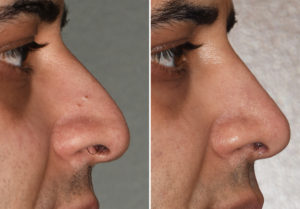Ethnicity is very intertwined with rhinoplasty surgery. For this reason, there are different considerations for each major ethnic group. The key to successful ethnic rhinoplasties is to refine the nose but not try and eliminate the beautiful features of one’s ethnicity. It is not a realistic patient goal or a surgical objective to make a nose that is racially incongruous with the rest of the face.
The Middle Eastern nose is no different. They have a number of features which can be improved to put the nose in better balance. These often include a nasal hump to some degree, wide nasal bones with a broad bridge, a long nose from which the tip droops downward, and a wide and ill-defined nasal tip. Compounding this appearance and limiting what surgical result can be achieved is a coevrage of overlying thick skin. Understand that I am speaking here about an ‘average’ Middle Eastern nose, I have certainly seen some females that actually have a narrow nose with thinner skin but with a large hump and a plunging tip.

Nasal hump reduction is almost always needed and the goal here is to have a smooth dorsal line, not a scooped-out upper nasal appearance. A high dorsal line is much more congruous with the Middle Eastern face than a low dorsal profile. When manipulating the dorsal line, it is not usually possible to create a noticeable supratip break without cartilage over-resection. But that is still satisfactory as its presence is not an ethnic nasal characteristic.
Middle Eastern rhinoplasty is challenging but if one stays within the boundaries of racial harmony, good results can be consistently achieved.
Dr. Barry Eppley
Indianapolis, Indiana


